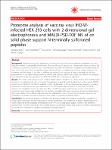Proteome analysis of vaccinia virus IHD-W-infected HEK 293 cells with 2-dimensional gel electrophoresis and MALDI-PSD-TOF MS of on solid phase support N-terminally sulfonated peptides
Bartel, Sebastian
Döllinger, Jörg
Darsow, Kai
Bourquain, Daniel
Buchholz, Rainer
Nitsche, Andreas
Lange, Harald A.
Background: Despite the successful eradication of smallpox by the WHO-led vaccination programme, pox virus infections remain a considerable health threat. The possible use of smallpox as a bioterrorism agent as well as the continuous occurrence of zoonotic pox virus infections document the relevance to deepen the understanding for virus host interactions. Since the permissiveness of pox infections is independent of hosts surface receptors, but correlates with the ability of the virus to infiltrate the antiviral host response, it directly depends on the hosts proteome set. In this report the proteome of HEK293 cells infected with Vaccinia Virus strain IHD-W was analyzed by 2-dimensional gel electrophoresis and MALDI-PSD-TOF MS in a bottom-up approach. Results: The cellular and viral proteomes of VACV IHD-W infected HEK293 cells, UV-inactivated VACV IHD-W-treated as well as non-infected cells were compared. Derivatization of peptides with 4-sulfophenyl isothiocyanate (SPITC) carried out on ZipTipμ-C18 columns enabled protein identification via the peptides’ primary sequence, providing improved s/n ratios as well as signal intensities of the PSD spectra. The expression of more than 24 human proteins was modulated by the viral infection. Effects of UV-inactivated and infectious viruses on the hosts’ proteome concerning energy metabolism and proteins associated with gene expression and protein-biosynthesis were quite similar. These effects might therefore be attributed to virus entry and virion proteins. However, the modulation of proteins involved in apoptosis was clearly correlated to infectious viruses. Conclusions: The proteome analysis of infected cells provides insight into apoptosis modulation, regulation of cellular gene expression and the regulation of energy metabolism. The confidence of protein identifications was clearly improved by the peptides’ derivatization with SPITC on a solid phase support. Some of the identified proteins have not been described in the context of poxvirus infections before and need to be further characterised to identify their meaning for apoptosis modulation and pathogenesis.
No license information

